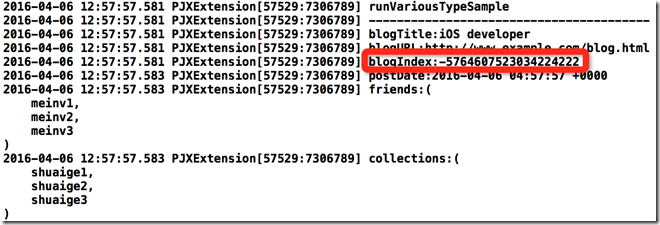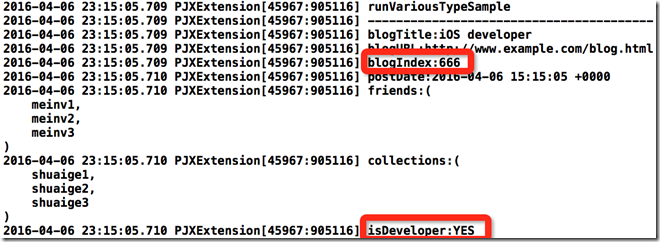【疯狂造轮子-iOS】JSON转Model系列之二
【疯狂造轮子-iOS】JSON转Model系列之二
本文转载请注明出处 —— polobymulberry-博客园
1. 前言
上一篇《【疯狂造轮子-iOS】JSON转Model系列之一》实现了一个简陋的JSON转Model的库,不过还存在很多问题。下面我会尝试一个个去解决。
2. 存在问题及解决思路
2.1 没有考虑JSON数据并不一定是NSDictionary类型
有时候JSON并不一定是NSDictionary类型,可能是一个字符串,也可能是NSData类型的数据。不过不管是哪种类型,统统先将其转化为NSData数据,然后使用+[NSJSONSerialization JSONObjectWithData:options:error:]来转化。所以我在initWithAttributes:上面又封装了一层。
- - (instancetype)initWithJSONData:(id)json
- {
- NSDictionary *dict = [self pjx_dictionaryWithJSON:json];
- return [self initWithAttributes:dict];
- }
- /**
- * @brief 将NSString和NSData格式的json数据转化为NSDictionary类型
- */
- - (NSDictionary *)pjx_dictionaryWithJSON:(id)json
- {
- if (!json) {
- return nil;
- }
- // 若是NSDictionary类型,直接返回
- if ([json isKindOfClass:[NSDictionary class]]) {
- return json;
- }
- NSDictionary *dict = nil;
- NSData *jsonData = nil;
- if ([json isKindOfClass:[NSString class]]) {
- // 如果是NSString,就先转化为NSData
- jsonData = [(NSString*)json dataUsingEncoding:NSUTF8StringEncoding];
- } else if ([json isKindOfClass:[NSData class]]) {
- jsonData = json;
- }
- if (jsonData && [jsonData isKindOfClass:[NSData class]]) {
- // 如果时NSData类型,使用NSJSONSerialization
- NSError *error = nil;
- dict = [NSJSONSerialization JSONObjectWithData:jsonData options: error:&error];
- if (error) {
- NSLog(@"pjx_dictionaryWithJSON error:%@", error);
- return nil;
- }
- if (![dict isKindOfClass:[NSDictionary class]]) {
- return nil;
- }
- }
- return dict;
- }
为此,我在ViewController添加了两个sample。分别用来解析NSString类型的JSON数据和NSData类型的JSON数据。
- // NSString类型的JSON数据
- - (void)runSimpleSample2
- {
- NSString *userStr = @" \
- { \
- \"username\" : \"shuaige\", \
- \"password\" : \"123456\", \
- \"avatarImageURL\" : \"http://www.example.com/shuaige.png\" \
- }";
- PJXUser *user = [[PJXUser alloc] initWithJSONData:userStr];
- NSLog(@"runSimpleSample2\n");
- NSLog(@"----------------------------------------");
- NSLog(@"username:%@\n",user.username);
- NSLog(@"password:%@\n",user.password);
- NSLog(@"avatarImageURL:%@\n",user.avatarImageURL);
- }
- // NSData类型的JSON数据
- - (void)runSimpleSample3
- {
- NSString *userInfoFilePath = [[NSBundle mainBundle] pathForResource:@"UserInfo" ofType:@"txt"];
- NSData *data = [NSData dataWithContentsOfFile:userInfoFilePath];
- PJXUser *user = [[PJXUser alloc] initWithJSONData:data];
- NSLog(@"runSimpleSample3\n");
- NSLog(@"----------------------------------------");
- NSLog(@"username:%@\n",user.username);
- NSLog(@"password:%@\n",user.password);
- NSLog(@"avatarImageURL:%@\n",user.avatarImageURL);
- }
输出结果也是正确的:

2.2 没有考虑用户传入的JSON数据的key值和property的名称不一致
我第一反应是使用一个映射表。也就是说用户使用时需要自定义一套property和key的映射表。YYModel中使用了一个+ (NSDictionary *)modelCustomPropertyMapper函数,用户可以自定义该函数达到映射表的效果,而这个函数是放在一个protocol中的。我挺认同这种设计的,因为modelCustomPropertyMapper这种函数和Model是一种组合关系,可有可无(optional),所以设计成协议更合适。但是作者在设计protocol又说了一句:
- // There's no need to add '<YYModel>' to your class header.
- @protocol YYModel <NSObject>
什么意思呢,就是说你自定义一个NSObject子类(如YYBook)时,如果想实现自定义的property映射关系,只需要实现modelCustomPropertyMapper函数即可,而不需要写成@interface YYBook : NSObject <YYModel>。作者的意思是你遵不遵循YYModel这个protocol都没事,反正你只要在YYBook实现了modelCustomPropertyMapper即可。具体解释,大家请参考这个issue。
这种设计我不是很赞同,我是有洁癖的人,要不然你就别定义YYModel这个protocol,说明文档里面着重说明一下就行。所以此处我还是选择判断NSObject的子类是否遵循protocol,也就是说只有遵循了这个protocol,才能自定义property映射关系。
首先我们看如何使用自定义propertyMapper。我先建立一个PJXUserPropertyMapper类,遵循了JSONProtocol协议,并实现了propertyMapper协议函数。
- // 遵循JSONProtocol协议,这个JSONProtocol中定义的就是我的propertyMapper协议函数
- @interface PJXUserPropertyMapper : NSObject <JSONProtocol>
- @property (nonatomic, copy) NSString* username; // 用户名
- @property (nonatomic, copy) NSString* password; // 密码
- @property (nonatomic, copy) NSString* avatarImageURL; // 头像的URL地址
- @end
- @implementation PJXUserPropertyMapper
- // 实现propertyMapper这个协议方法
- + (NSDictionary *)propertyMapper
- {
- return @{@"Username" : @"username",
- @"Password" : @"password",
- @"AvatarImageURL" : @"avatarImageURL"};
- }
- @end
随后我定义了一个example。
- #pragma mark - PropertyMapper Sample
- - (void)runPropertyMapperSample
- {
- NSDictionary *userDict = @{@"Username" : @"shuaige",
- @"Password" : @"",
- @"AvatarImageURL" : @"http://www.example.com/shuaige.png"};
- PJXUserPropertyMapper *user = [[PJXUserPropertyMapper alloc] initWithJSONData:userDict];
- NSLog(@"runPropertyMapperSample\n");
- NSLog(@"----------------------------------------");
- NSLog(@"username:%@\n",user.username);
- NSLog(@"password:%@\n",user.password);
- NSLog(@"avatarImageURL:%@\n",user.avatarImageURL);
- }
是不是感觉调用上和之前的非property映射没什么区别?那是因为我们需要在initWithJSONData中增加一些东西。
具体的做法是在PropertyWithDictionary函数增加了一个查表操作。
- // 注意我传入的dictionary就是用户提供的JSON数据
- // 比如此处传入的key==@"username",value==@"shuaige"
- static void PropertyWithDictionaryFunction(const void *key, const void *value, void *context)
- {
- NSString *keyStr = (__bridge NSString *)(key);
- ......
- // 如果使用了JSONProtocol,并且自定义了propertyMapper,那么还需要将keyStr转化下
- if ([modelSelf conformsToProtocol:@protocol(JSONProtocol)] && [[modelSelf class] respondsToSelector:@selector(propertyMapper)]) {
- keyStr = [[[modelSelf class] propertyMapper] objectForKey:keyStr];
- }
- ......
- }
这样就可以啦.我们看看效果:

2.3 没有考虑JSON数据的value值不一定是NSString类型
开始的时候,挺担心我这种写法会不会不兼容别的数据类型。不过我觉得应该没什么问题,毕竟我使用的setter方法本质上没啥问题,我的类型全用id来代替了(事实上,我的想法大错特错):
- ((void (*)(id, SEL, id))(void *) objc_msgSend)(modelSelf, info.setter, setValue);
不过本着不怕一万,就怕万一的心态。我还是做了一个example来试验一下:
- @interface PJXUserVariousType : NSObject
- @property (nonatomic, copy) NSString *blogTitle; // 博客标题
- @property (nonatomic, strong) NSURL *blogURL; // 博客网址
- @property (nonatomic, assign) NSInteger blogIndex; // 博客索引值
- @property (nonatomic, strong) NSDate *postDate; // 博客发布时间
- @property (nonatomic, strong) NSArray *friends; // 我的好友名称
- @property (nonatomic, strong) NSSet *collections; // 我的收藏
- @end
- @implementation PJXUserVariousType
- @end
- #pragma mark - VariousType Sample
- - (void)runVariousTypeSample
- {
- NSDictionary *userDict = @{@"blogTitle" : @"iOS developer",
- @"blogURL" : @"http://www.example.com/blog.html",
- @"blogIndex" : @,
- @"postDate" : [NSDate date],
- @"friends" : @[@"meinv1", @"meinv2", @"meinv3"],
- @"collections" : @[@"shuaige1", @"shuaige2", @"shuaige3"]};
- PJXUserVariousType *user = [[PJXUserVariousType alloc] initWithJSONData:userDict];
- NSLog(@"runVariousTypeSample\n");
- NSLog(@"----------------------------------------");
- NSLog(@"blogTitle:%@\n",user.blogTitle);
- NSLog(@"blogURL:%@\n",user.blogURL);
- NSLog(@"blogIndex:%ld\n",user.blogIndex);
- NSLog(@"postDate:%@\n",user.postDate);
- NSLog(@"friends:%@\n",user.friends);
- NSLog(@"collections:%@\n",user.collections);
- }
你猜输出啥?

其他都正确,唯独我们的blogIndex出错了。这里确实是我欠考虑了,类似NSInteger,BOOL这些NSNumber类型(我暂时只考虑这些常用类型)需要单独处理一下。这一部分看起来容易,但是为了处理这种特殊情况确实要下很大功夫。比如你得先判断该属性是不是double或int这种类型,只有判断除了该属性是double还是int,你才能正确使用setter方法,而此处的调用方式也要单独写一个,因为和之前调用方式有一些些区别,需要判断Number的类型是double,是int,还是BOOl…….
对此我在PJXPropertyInfo中定义了两个函数,一个叫isNumber,用来判断该属性是不是一个Number,另一个叫setNumberValue:withModelSelf:,用来给是Number类型的属性赋值。另外,我仿照YYModel(比YYModel简化很多了)建了一个PJXEncodingType的enum类型,用来存储Number的类型(int?double?BOOL?……),与之配套的还有一个PJXGetEncodingType函数,来获取当前属性的类型(是int?double?BOOL?),具体怎么做还挺复杂的,后面会详细说明。
代码如下:
- // Number类型
- typedef NS_ENUM(NSUInteger, PJXEncodingType) {
- PJXEncodingTypeUnknown = , ///< unknown
- PJXEncodingTypeBool = 1, ///< bool
- PJXEncodingTypeInt8 = 2, ///< char / BOOL
- PJXEncodingTypeUInt8 = 3, ///< unsigned char
- PJXEncodingTypeInt16 = 4, ///< short
- PJXEncodingTypeUInt16 = 5, ///< unsigned short
- PJXEncodingTypeInt32 = 6, ///< int
- PJXEncodingTypeUInt32 = 7, ///< unsigned int
- PJXEncodingTypeInt64 = 8, ///< long long
- PJXEncodingTypeUInt64 = 9, ///< unsigned long long
- PJXEncodingTypeFloat = 10, ///< float
- PJXEncodingTypeDouble = 11, ///< double
- PJXEncodingTypeLongDouble = 12, ///< long double
- };
- // 根据objc_property_attribute_t可以获取到property的类型PJXEncodingType
- // 参考YYModel
- PJXGetEncodingType(const char *encodingType) {
- char *type = (char *)encodingType;
- if (!type) return PJXEncodingTypeUnknown;
- size_t len = strlen(type);
- if (len == ) return PJXEncodingTypeUnknown;
- switch (*type) {
- case 'B': return PJXEncodingTypeBool;
- case 'c': return PJXEncodingTypeInt8;
- case 'C': return PJXEncodingTypeUInt8;
- case 's': return PJXEncodingTypeInt16;
- case 'S': return PJXEncodingTypeUInt16;
- case 'i': return PJXEncodingTypeInt32;
- case 'I': return PJXEncodingTypeUInt32;
- case 'l': return PJXEncodingTypeInt32;
- case 'L': return PJXEncodingTypeUInt32;
- case 'q': return PJXEncodingTypeInt64;
- case 'Q': return PJXEncodingTypeUInt64;
- case 'f': return PJXEncodingTypeFloat;
- case 'd': return PJXEncodingTypeDouble;
- case 'D': return PJXEncodingTypeLongDouble;
- default: return PJXEncodingTypeUnknown;
- }
- }
- /**
- * @brief 存储Model中每个property的信息
- * ......
- * @param type 是一个PJXEncodingType类型变量,为了存储该属性是哪种Number(int?double?BOOL?)
- */
- @interface PJXPropertyInfo : NSObject
- ......
- @property (nonatomic, assign) PJXEncodingType type;
- @end
- @implementation PJXPropertyInfo
- - (instancetype)initWithPropertyInfo:(objc_property_t)property
- {
- self = [self init];
- if (self) {
- ......
- // 判断属性类型
- unsigned int attrCount;
- // 关于objc_property_attribute_t,这里有一篇文章介绍的很好
- // http://www.henishuo.com/runtime-property-ivar/
- objc_property_attribute_t *attrs = property_copyAttributeList(property, &attrCount);
- for (unsigned int i = ; i < attrCount; i++) {
- switch (attrs[i].name[]) {
- case 'T': {// EncodingType
- if (attrs[i].value) {
- //NSLog(@"attrs[%d].value = %s", i, attrs[i].value);
- // 可以根据value获取到property类型
- _type = PJXGetEncodingType(attrs[i].value);
- }
- break;
- }
- default:
- break;
- }
- }
- ......
- }
- return self;
- }
- // 根据propertyInfo中存储的type判断其是否为Number
- - (BOOL)isNumber
- {
- switch (self.type) {
- case PJXEncodingTypeBool:
- case PJXEncodingTypeInt8:
- case PJXEncodingTypeUInt8:
- case PJXEncodingTypeInt16:
- case PJXEncodingTypeUInt16:
- case PJXEncodingTypeInt32:
- case PJXEncodingTypeUInt32:
- case PJXEncodingTypeInt64:
- case PJXEncodingTypeUInt64:
- case PJXEncodingTypeFloat:
- case PJXEncodingTypeDouble:
- case PJXEncodingTypeLongDouble:
- return YES;
- default:
- return NO;
- break;
- }
- }
- // 使用objc_msgSend调用modelSelf中该属性对应的setter方法
- - (void)setNumberValue:(NSNumber *)number withModelSelf:(id)modelSelf
- {
- switch (self.type) {
- case PJXEncodingTypeBool:
- ((void (*)(id, SEL, BOOL))(void *) objc_msgSend)(modelSelf, self.setter, number.boolValue);
- break;
- case PJXEncodingTypeInt8:
- ((void (*)(id, SEL, BOOL))(void *) objc_msgSend)(modelSelf, self.setter, number.charValue);
- break;
- case PJXEncodingTypeUInt8:
- ((void (*)(id, SEL, BOOL))(void *) objc_msgSend)(modelSelf, self.setter, number.unsignedCharValue);
- break;
- case PJXEncodingTypeInt16:
- ((void (*)(id, SEL, BOOL))(void *) objc_msgSend)(modelSelf, self.setter, number.shortValue);
- break;
- case PJXEncodingTypeUInt16:
- ((void (*)(id, SEL, BOOL))(void *) objc_msgSend)(modelSelf, self.setter, number.unsignedShortValue);
- break;
- case PJXEncodingTypeInt32:
- ((void (*)(id, SEL, BOOL))(void *) objc_msgSend)(modelSelf, self.setter, number.intValue);
- break;
- case PJXEncodingTypeUInt32:
- ((void (*)(id, SEL, BOOL))(void *) objc_msgSend)(modelSelf, self.setter, number.unsignedIntValue);
- break;
- case PJXEncodingTypeInt64:
- ((void (*)(id, SEL, uint64_t))(void *) objc_msgSend)(modelSelf, self.setter, number.longLongValue);
- break;
- case PJXEncodingTypeUInt64:
- ((void (*)(id, SEL, uint64_t))(void *) objc_msgSend)(modelSelf, self.setter, number.unsignedLongLongValue);
- break;
- case PJXEncodingTypeFloat:
- ((void (*)(id, SEL, float))(void *) objc_msgSend)(modelSelf, self.setter, number.floatValue);
- break;
- case PJXEncodingTypeDouble:
- ((void (*)(id, SEL, double))(void *) objc_msgSend)(modelSelf, self.setter, number.doubleValue);
- break;
- case PJXEncodingTypeLongDouble:
- ((void (*)(id, SEL, long double))(void *) objc_msgSend)(modelSelf, self.setter, number.doubleValue);
- break;
- default:
- break;
- }
- }
- @end
有了上述的几个方法,后面就好办了,只需在PropertyWithDictionaryFunction函数中添加一个Number的判断就行:
- static void PropertyWithDictionaryFunction(const void *key, const void *value, void *context)
- {
- ......
- // 如果该属性是Number,那么就用Number赋值方法给其赋值
- if ([info isNumber]) {
- [info setNumberValue:setValue withModelSelf:modelSelf];
- } else {
- ((void (*)(id, SEL, id))(void *) objc_msgSend)(modelSelf, info.setter, setValue);
- }
- }
这下终于成功了:

2.4 没有考虑用户自定义了Model属性的setter方法
这个其实比较简单,只需要对property的attribute(objc_property_attribute_t)进行判断即可:
- - (instancetype)initWithPropertyInfo:(objc_property_t)property
- {
- ......
- BOOL isCustomSetter = NO;
- // 判断属性类型
- unsigned int attrCount;
- // 关于objc_property_attribute_t,这里有一篇文章介绍的很好
- // http://www.henishuo.com/runtime-property-ivar/
- objc_property_attribute_t *attrs = property_copyAttributeList(property, &attrCount);
- for (unsigned int i = ; i < attrCount; i++) {
- switch (attrs[i].name[]) {
- case 'T': { // EncodingType
- if (attrs[i].value) {
- //NSLog(@"attrs[%d].value = %s", i, attrs[i].value);
- // 可以根据value获取到property类型
- _type = PJXGetEncodingType(attrs[i].value);
- }
- break;
- }
- case 'S': { // 自定义setter方法
- if (attrs[i].value) {
- isCustomSetter = YES;
- _setter = NSSelectorFromString([NSString stringWithUTF8String:attrs[i].value]);
- }
- } break;
- default:
- break;
- }
- }
- if (!isCustomSetter) {
- // 如果没有自定义setter方法,只考虑系统默认生成setter方法
- // 也就是说属性username的setter方法为setUsername:
- NSString *setter = [NSString stringWithFormat:@"%@%@", [_name substringToIndex:].uppercaseString, [_name substringFromIndex:]];
- _setter = NSSelectorFromString([NSString stringWithFormat:@"set%@:", setter]);
- }
- }
- return self;
- }
使用下面这个例子测试:
- @interface PJXUserCustomSetter : NSObject
- @property (nonatomic, copy, setter=setCustomUserName:) NSString* username; // 用户名
- @property (nonatomic, copy, setter=setCustomBirthday:) NSDate* birthday; // 生日
- @end
- @implementation PJXUserCustomSetter
- - (void)setCustomUserName:(NSString *)username
- {
- _username = [NSString stringWithFormat:@"My name is %@", username];
- }
- - (void)setCustomBirthday:(NSDate *)birthday
- {
- NSTimeInterval timeInterval = **; // 过一天
- _birthday = [NSDate dateWithTimeInterval:timeInterval sinceDate:birthday];
- }
- @end
- #pragma mark - Custom Setter Sample
- - (void)runCustomSetterSample
- {
- NSDateFormatter *dateFormatter = [[NSDateFormatter alloc] init];
- [dateFormatter setDateFormat:@"yyyy-MM-dd HH:mm:ss"];
- NSDate *birthday = [dateFormatter dateFromString:@"2016-04-07 00:20:03"];
- NSDictionary *userDict = @{@"username" : @"shuaige",
- @"birthday" : birthday};
- PJXUserCustomSetter *user = [[PJXUserCustomSetter alloc] initWithJSONData:userDict];
- NSLog(@"runCustomSetterSample\n");
- NSLog(@"----------------------------------------");
- NSLog(@"username:%@\n",user.username);
- NSLog(@"birthday:%@\n",user.birthday);
- }
得到的结果为:

成功了.
2.5 没有考虑用户传入的JSON数据有嵌套
我个人感觉这个应该没什么问题,为什么这么说呢?因为我嵌套的无非也是一个NSObject类型,那么就调用其自身的setter方法就OK啊.不过还是以防万一,我构造了一下案例:
- @interface PJXBlog : NSObject
- @property (nonatomic, copy) NSString *title; // 博客名称
- @property (nonatomic, strong) NSDate *postDate; // 博客发表日期
- @property (nonatomic, copy) PJXUser *author; // 博客作者
- @end
- @implementation PJXBlog
- @end
- #pragma mark - Nest Sample
- - (void)runNestSample
- {
- NSDictionary *blogDict = @{@"title" : @"how to convert JSON to Model?",
- @"postDate" : [NSDate date],
- @"author" : @{@"username" : @"shuaige",
- @"password" : @"",
- @"avatarImageURL":@"http://www.example.com/shuaige.png"}};
- PJXBlog *blog = [[PJXBlog alloc] initWithJSONData:blogDict];
- NSLog(@"runNestSample\n");
- NSLog(@"----------------------------------------");
- NSLog(@"title:%@\n",blog.title);
- NSLog(@"postDate:%@\n",blog.postDate);
- NSLog(@"author:%@\n",blog.author);
- }
输出结果如下:

结果没什么问题.不过这样说可能不是很负责任,但是目前我也想不到反例.暂时先当做成功了.
3. 总结
以我的能力,目前只能将JSON转化Model实现到这个地步了.总体来说,实现的难度不是很大(因为我考虑的情况还是比较少的,另外还有些功能没添加),不过涉及的知识点还是挺多的,挺不错的一个练手项目:).
附上GitHub地址。
【疯狂造轮子-iOS】JSON转Model系列之二的更多相关文章
- 【疯狂造轮子-iOS】JSON转Model系列之一
[疯狂造轮子-iOS]JSON转Model系列之一 本文转载请注明出处 —— polobymulberry-博客园 1. 前言 之前一直看别人的源码,虽然对自己提升比较大,但毕竟不是自己写的,很容易遗 ...
- Mac iOS Json 操作Model to JSON
在移动网络时代,json成为了主流的数据交换格式.如何能够方便快捷的创建.转化.传递json文件称为了开发者必备的技能.幸好,我们生活在开源时代,很多功能不需要我们重现造轮子.今天我推荐一款开源jso ...
- “造轮运动”之 ORM框架系列(二)~ 说说我心目中的ORM框架
ORM概念解析 首先梳理一下ORM的概念,ORM的全拼是Object Relation Mapping (对象关系映射),其中Object就是面向对象语言中的对象,本文使用的是c#语言,所以就是.ne ...
- ios json转model的简单现实
在android开发中,可用第三方的转换库如gson等.当然在ios也有一些库如MJExtensiond等.在这里,我简单实现一下. 一.先建一个model并且继承NSObject,代码如下: cla ...
- 重复造轮子系列——基于Ocelot实现类似支付宝接口模式的网关
重复造轮子系列——基于Ocelot实现类似支付宝接口模式的网关 引言 重复造轮子系列是自己平时的一些总结.有的轮子依赖社区提供的轮子为基础,这里把使用过程的一些觉得有意思的做个分享.有些思路或者方法在 ...
- 造轮子系列之RPC 1:如何从零开始开发RPC框架
前言 RPC 框架是后端攻城狮永远都绕不开的知识点,目前业界比较知名有 Dubbo.Spring Cloud 等.很多人都停留在了只会用的阶段,作为程序猿,拥有好奇心深入学习,才能有效提高自己的竞争力 ...
- GitHub Android 最火开源项目Top20 GitHub 上的开源项目不胜枚举,越来越多的开源项目正在迁移到GitHub平台上。基于不要重复造轮子的原则,了解当下比较流行的Android与iOS开源项目很是必要。利用这些项目,有时能够让你达到事半功倍的效果。
1. ActionBarSherlock(推荐) ActionBarSherlock应该算得上是GitHub上最火的Android开源项目了,它是一个独立的库,通过一个API和主题,开发者就可以很方便 ...
- 自己造轮子系列之OOM框架AutoMapper
[前言] OOM框架想必大家在Web开发中是使用频率非常之高的,如果还不甚了解OOM框架,那么我们对OOM框架稍作讲解. OOM顾名思义,Object-Object-Mapping实体间相互转换.常见 ...
- 重复造轮子系列——基于FastReport设计打印模板实现桌面端WPF套打和商超POS高度自适应小票打印
重复造轮子系列——基于FastReport设计打印模板实现桌面端WPF套打和商超POS高度自适应小票打印 一.引言 桌面端系统经常需要对接各种硬件设备,比如扫描器.读卡器.打印机等. 这里介绍下桌面端 ...
随机推荐
- 防御XSS攻击-encode用户输入内容的重要性
一.开场先科普下XSS 跨站脚本攻击(Cross Site Scripting),为不和层叠样式表(Cascading Style Sheets, CSS)的缩写混淆,故将跨站脚本攻击缩写为XSS.恶 ...
- 关于Unity3D自定义编辑器的学习
被人物编辑器折腾了一个月,最终还是交了点成品上去(还要很多优化都还么做). 刚接手这项工作时觉得没概念,没想法,不知道.后来就去看<<Unity5.X从入门到精通>>中有关于 ...
- C#高性能TCP服务的多种实现方式
哎~~ 想想大部分园友应该对 "高性能" 字样更感兴趣,为了吸引眼球所以标题中一定要突出,其实我更喜欢的标题是<猴赛雷,C#编写TCP服务的花样姿势!>. 本篇文章的主 ...
- Linux CentOS 配置JDK环境
一.下载JDK 下载JDK的方式有两种: 1.Linux中使用wget下载 1.使用命令安装wget yum install wget 2.下载 wget 'http://download.oracl ...
- iOS二维码生成、识别、扫描等
二维码扫描 前言: 最近的项目中使用到了二维码,二维码这个模块功能也完成:觉得还是有必要总结一下用来做记录.好长时间没有写二维码了都忘记在差不多了,重新拾起来还是挻快的. 二维码使用场景: 生活中有很 ...
- JavaScript的继承实现方式
1.使用call或apply方法,将父对象的构造函数绑定在子对象上 function A(){ this.name = 'json'; } function B(){ A.call(this); } ...
- 一起学微软Power BI系列-使用技巧(3)Power BI安卓手机版安装与体验
Power BI有手机版,目前支持安卓,苹果和WP,不过没有WP手机,苹果在国内还不能用,要FQ和用就不测试了.安卓的我也也是费了九牛二虎之力才把app下载下来,把方法分享给大家. FQ太麻烦,所以建 ...
- 主成分分析(PCA)原理总结
主成分分析(Principal components analysis,以下简称PCA)是最重要的降维方法之一.在数据压缩消除冗余和数据噪音消除等领域都有广泛的应用.一般我们提到降维最容易想到的算法就 ...
- C#语法糖大汇总
首先需要声明的是"语法糖"这个词绝非贬义词,它可以给我带来方便,是一种便捷的写法,编译器会帮我们做转换:而且可以提高开发编码的效率,在性能上也不会带来损失.这让java开发人员羡慕 ...
- 用angular怎么缓存父页面数据
angular做单页面应用是一个比较好的框架,但是它有一定的入门难度,对于新手来说可能会碰到很多坑,也有许多难题,大部分仔细看文档,找社区是能解决的. 但有些问题也许资料比较少,最近遇到过一个要缓存父 ...
